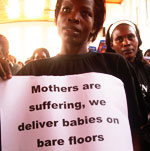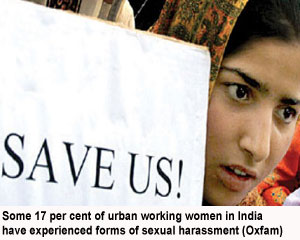
The unpaid work carried out by women, such as child care, should be more recognised

FRONT PAGE
Site Search
About us
  

Women in cities
US abortion debate
America's children of prisoners

Worldwide | Elections | North America | Latin America | Europe | Asia | Africa |



























|
|
Women in cities give much
but take far less than men
A report by UN Habitat* reviewed by Brian Baker
7 May 2013: Women in developing countries contribute significantly to the prosperity of cities but they are often the last to benefit. This becomes evident, a new report says, in notable gender gaps in labour and employment, pay, tenure rights, access to and accumulation of assets, personal security and safety and representation in formal structures of urban governance. The report Gender and the Prosperity of Cities from the UN Habitat Settlements Programme recommends that cities formulate gender policies, strengthen accountability for gender equality and enhance strategies for the economic empowerment and livelihoods of women living in them. The delivery of basic services is also, say the authors, along with economic strategies, a key requisite for equitable city prosperity.
The UN Habitat report on ‘Women and Cities; Gender and the Prosperity of Cities, written by Lucia Kiwala and Oyebanji Oyelaran-Oyayinka draws heavily on a survey conducted for UN Habitat in five large cities: Rio de Janeiro, Kingston, Johannesburg, Kampala and Bangalore. The researchers interviewed nearly 700 decision-makers, policy makers and ‘informal’ urban dwellers. Their perceptions of city policies and management are predominantly negative and should prompt leaders and officials towards changes, which better reflect their populations and their needs and potential.
 UN Human Settlements Programme Executive Director and former mayor of Barcelona, Joan Clos, says in his forward to the report “our study shows that urbanisation is largely associated with the prosperity of women in theory whilst in practice few women actually benefit from economic growth and prosperity of cities.” UN Human Settlements Programme Executive Director and former mayor of Barcelona, Joan Clos, says in his forward to the report “our study shows that urbanisation is largely associated with the prosperity of women in theory whilst in practice few women actually benefit from economic growth and prosperity of cities.”
“The time is now ripe for cities and local governments to put in place gender equality policies, strategies and programmes which promote livelihoods and economic empowerment of women,” he adds. Clos says the difference between theory and practice was largely a result of discriminatory practices and the undervaluation of work done by women in the informal sector.
The report makes two recommendations, which are aimed directly at city leaders. They are that women economic empowerment strategies and livelihoods should be strengthened within the planning of cities and the delivery of basic services as key pre-requisites for equitable city prosperity and that gender policies should be formulated and accountability for gender equality and equity at city level should be strengthened.
The policy actions, which reflect the two key recommendations are grouped under three headings – Quality of life and infrastructure, productivity and equity in power and rights. Amongst these are actions which better recognise the unpaid work done by women, notably in reproduction and early years care, which deliver pro-female housing rights initiatives, invest more in clean water and sanitation, skills training, support instead of restriction for home-based entrepreneurship, and which ensure gender-sensitive measures are focussed on paid rather than unpaid work.
The report is strongest in highlighting some of the less well understood discriminations, notably in both land and property ownership and in the rental sector and in its emphasis on the great significance of our demographic pathway. Safe, secure housing is a challenge for women throughout the world and is by no means restricted to those in poverty circumstances. Respondents to the survey emphasised the perception that, in most cities, a majority of women had no access to secure housing. The survey also revealed the broad base of concerns about general safety too- unsurprising perhaps.
The demographic trends may be the biggest prompt for changes both in city government and other spheres. Cities are forecast to have a high proportion of women over 60 amongst their residents and an increasing proportion of female-headed households. More challenging for governments trying to do something about basic services are the projections for a significant population of women over 80.
The authors link the relative longevity of women in developing countries compared to men with the high incidence of older women in poverty with the constraints on increased prosperity in cities in the developing world.
The importance of women, and of their economic empowerment, in the cities of the developing world has been increased by recent patterns of inward migration. The report authors note that more women than men have moved to towns and cities throughout South America for several decades now and this pattern has more recently become established in Vietnam and Thailand.
This is less the case in South Asia and Sub-Saharan Africa notably through the restrictions on women living independent lives but has become more of a trend lately in part because of the economic disadvantages especially in relation to land experienced by women in rural areas. The policy actions urged on city leaders highlight the role played by women as carers in urban societies and also the failure by governments and local governments to recognise this and respond to it across the globe.
The five cities in the survey are all very large and important although the overwhelming majority of the recently urbanised female population at risk of or in poverty are most likely to live in small and medium sized urban areas. This is explicitly recognised in the text, however, in relation to current movement patterns in the most urbanised of the countries of South America. Authors note that people have begun to move from major metropolis cities to smaller, less congested and perceptibly less polluted cities.
Of the five survey cities, one, Kingston (Jamaica) is the only large urban area on a small island and one, Rio de Janeiro (Brazil), is in an increasingly prosperous country and will soon have an unprecedented period of global attention. The others, Johannesburg (South Africa), Bangalore (India) and Kampala (Uganda) are, perhaps, more typical of the growing mega cities of the developing world. All five cities, however, have large informal settlements of unauthorised housing.
The respondents in Rio were the most pessimistic and negative in their response to many of the questions about women’s share in urban prosperity and future prospects. This may, in part, reflect higher expectations. Rio and Kingston had the lowest proportion of respondents who thought that women in urban areas were prosperous and, along with Johannesburg, the highest proportion who thought that their cities were not safe. Rio even had the lowest proportion who thought women had an increasing extent of access to safe and secure public transport.
Even on basic infrastructure Rio respondents were negative with only 15 per cent saying it was adequate and half saying that sanitation deficiencies and the consequent burden of disease acted as barriers to female prosperity. Respondents in Bangalore shared this low opinion on sanitation.
In Johannesburg respondents thought highly of policies to promote female economic productivity. In Rio, once again, they did not. On education, unsurprisingly ranked key by the UN authors, it was the Kingston respondents who were most satisfied with provision for women. Only 27 per cent of respondents thought the government departments and city authorities used any sex – disaggregated data and evidence in their policies and programmes.
Most respondents in four of the cities, excluding Bangalore, considered the lack of productive employment opportunity and/or income poverty were the main barriers preventing the city from becoming more prosperous for women. However, they considered poor governance and weak institutions to form almost as significant a barrier.
The introduction to the report notes that whilst women in most developing countries contribute significantly to the prosperity of cities they are often the last to benefit. This is evidenced, they say, in notable gender gaps in labour and employment, pay, tenure rights, access to and accumulation of assets, personal security and safety and representation in formal structures of urban governance.
Joan Clos says that “the report is UN – Habitat’s contribution towards understanding the plight of women in cities.”
“Cities are recognised as engines of economic growth and centres of social, political, cultural and technological advancement. However, 21st Century cities and towns are divided and characterised by urban poverty amidst richness.”
“Women form the majority of the poor,” he says. “In some countries they comprise up to 70 per cent of those living in poverty in both urban and rural areas. Women migrate from rural to urban areas mainly in search of employment and in order to escape from poverty, gender based violence, gender discrimination and disinheritance.”
The former mayor of Barcelona says that all cities and others have to fully address gender and the prosperity of cities together. He sagely notes that cultures, value systems and beliefs and to a large extent development policies and programmes are not changing at the same pace as the demographic shifts. Without more urgent interventions cities may be damaged by this tension.
*State of Women in Cities 2012-2013. Gender and the Prosperity of Cities was published by the United Nations Human Settlements Programme in April 2013.
|
|

|




































 UN Human Settlements Programme Executive Director and former mayor of Barcelona, Joan Clos, says in his forward to the report “our study shows that urbanisation is largely associated with the prosperity of women in theory whilst in practice few women actually benefit from economic growth and prosperity of cities.”
UN Human Settlements Programme Executive Director and former mayor of Barcelona, Joan Clos, says in his forward to the report “our study shows that urbanisation is largely associated with the prosperity of women in theory whilst in practice few women actually benefit from economic growth and prosperity of cities.”